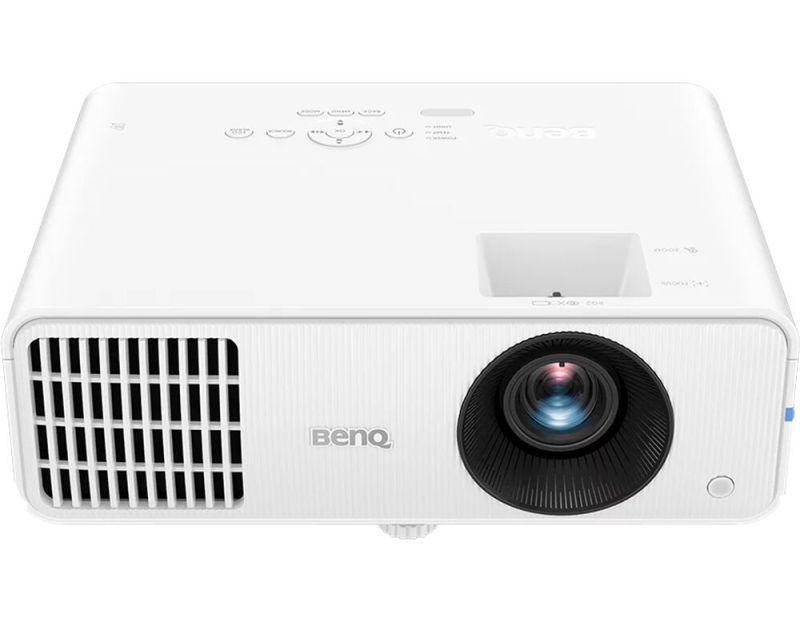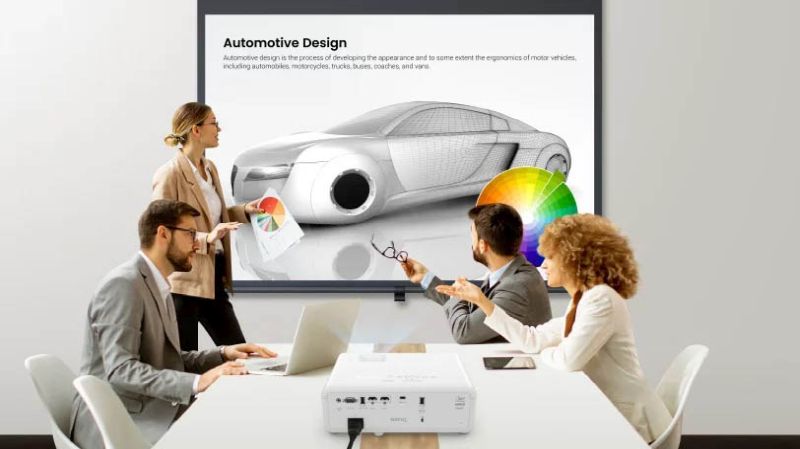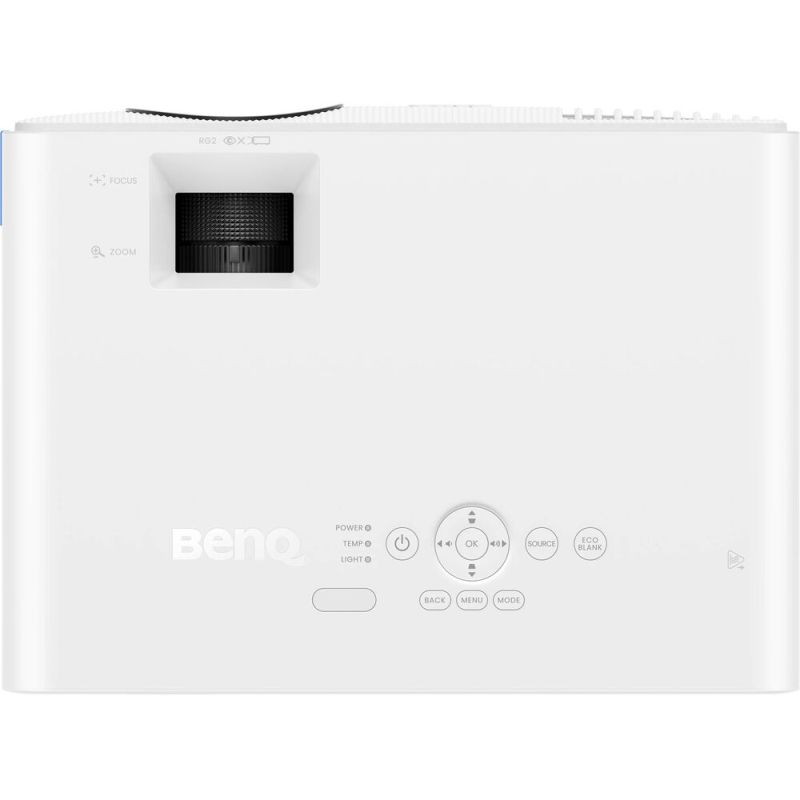With nearly 4,000 lumens on tap for everything from classroom lessons to conference room presentations, BenQ adds several tantalizing extras to this $1,199 general-purpose projector, including the ability to display USB-C video and an intelligent power-saving mode that barely diminishes its brightness.
- Bright business and classroom projector
- Laser illumination, sealed optics with no dust filter
- HDMI and USB-C port with alternate mode video
- Smart ECO mode
- Lacks built-in networking

Schools and businesses should take note of BenQ's LH650 general-purpose projector because it not only is among the first of its kind to offer USB-C's Alternate Mode video as an input option, but also an innovative, low-power Smart ECO 2.0 mode that reduces power consumption while largely maintaining brightness. By combining HD imaging and laser lighting with about 4,000 lumens of light on tap, the LH650's sealed optics means maintenance-free operations.
Unfortunately, like a lot of mid-range projectors these days, the LH650 does without wired networking or Wi-Fi, so it lacks the connection potential that some other projectors offer. Nonetheless, the BenQ LH650 does the basics well and has the potential to brighten up classrooms and conference rooms without busting the budget.
Features
Like so many mid-market conference room projectors today, the LH650 is built around a laser illumination engine. Its rated 20,000 hour lifetime is combined with IP5X sealed optics for as close to a zero maintenance projector as I've seen. There's no dust filter, although you'll need to occasionally clean the projector's inlet vent.

Under the surface, the LH650's light path combines powerful blue diode lasers with a phosphor wheel and a six-segment color wheel to deliver sequential streams of red, blue, green, cyan, magenta and yellow light. After the light is bounced off the projector's 0.65-inch Digital Light Processing (DLP) imaging target with 1080p native resolution, it goes through its output lens and on to the screen. BenQ is working on a similar model built around LED illumination components for extra freedom of choice.
The laser light source allows fine-tuning the LH650's output on a color by color basis as well as its innovative power-saving mode. In addition to the LH650's ECO mode, which dials back the power and brightness equally, BenQ's Smart ECO 2.0 scans the video stream frame by frame looking for color streams that aren't being used. By reducing the output of these idle components, the LH650's Smart ECO 2.0 lowered the projector's power use by about 6% in testing with only a slight loss of brightness that was between marginal (for Presentation mode) and 2% (for Infographic mode).
That seems like an equitable trade compared to the traditional ECO setting's brightness loss of 22% and power reduction of 23%. On the other hand, Smart ECO doesn't work in all of the projector's picture modes, but more on that later. While a good start, we hope that Smart ECO will be enhanced further to save even more power and to work across the board in all modes.
In the here and now, the LH650 can use anything from VGA to UHD inputs to deliver sharp 1920x1080 imaging that will be a step up for schools and businesses using older SVGA or XGA projectors. Its 1.3X zoom lens makes framing the image a snap, though like many projectors today it lacks a lens cap for when the projector needs to be moved or stored.

Able to project a 60-inch, 16:9 diagonal image from between 5 and 6.5 feet away, the LH650 tops out with a 25 foot (300-inch) diagonal image at between 25 feet and 32.8 feet throw distance. The sweet spot is probably closer to a maximum of 10-foot (approximately 120-inches). ProjectorCentral's BenQ LH650 Throw Calculator can preview the projector's abilities to see if they match up with its intended setting.
In addition to the projector's pair of HDMI video inputs, the LH650 takes a step forward with a USB-C port that supports Alternate Mode video input. It worked well with my Samsung Galaxy Tab S8 tablet and Google Pixel 7 phone and is likely the projector to get for connecting with phones, tablets and the latest notebooks without the need for an adapter. However, it does lack a video-out circuit for sending the on-screen content to a podium or second screen, as well as any legacy analog video ports that might come in handy in an older school or office.
Need a Lamp for Your Projector?
Browse ProjectorCentral's hand-picked list of Certified Lamp Sellers to find the right lamp at the best price.
Shop Lamps
Its 9-pin RS-232C serial port can be used for basic computer control, but the LH650 lacks built-in Wi-Fi or even RJ45 wired networking, and the projector doesn't work with remote software from Creston, AMX or PJLink. It does have two USB Type A connections that can power a streaming dongle, such as BenQ's $50 QCast Mirror EZC5201BS USB Wireless Dongle. It worked well with a Chromecast TV adapter.
Like many of its peers, the LH650 has a single 10-watt speaker. It sounded hollow even for spoken word content such as educational lessons or video conferences. The projector's audio-out jack can be used to connect the projector to external speakers.
The LH650 fits all its tech into a tidy 6.5-pound package at 11.9 x 4.4 x 8.8 inches (WHD). It's available only in white but should blend in with the background at a school or office. Its three adjustable feet are augmented by three threaded mounting points that worked well with my generic ceiling hardware. BenQ's $59 CM00G3 mount is a good alternative, with an adjustable pipe that can range from 5 to 22 inches.

A snap to set up, the LH650 has image shifting and keystone correction of angles of up to 30 degrees horizontally or vertically. BenQ's Corner Fit process for pulling out and pushing in the image's corners made squaring the image easy.
The LH650's current status is shown with its notification LEDs for Power, Temp and Light. To the right is a simple control panel with the basics, like four-way arrow keys with a central actuation key as well as dedicated buttons for picking the source, opening the menu and selecting the picture mode.
Its small remote control fits nicely in the hand, uses a pair of AAA batteries and had a 29-foot range. In addition to selecting the source, freezing the image and blanking the screen, it can put the projector into ECO mode. My favorite is the Quick Install key that provides access to the setup basics and a grid test pattern.
The LH650's three-year warranty can be optionally extended to five years for all business and education customers.
Performance
Color Modes. With five main Picture Modes available plus two user-defined presets, the BenQ LH650 can project a variety of school and business material. In addition to Bright and Presentation, the projector has picture mode settings for Spreadsheet, Video Conference and Infographic. It also has a mode for presenting 3D content.
There's nothing aimed at watching movies in a darkened room, however. BenQ certifies that the LH650 covers 92 percent of the Rec.709 standard that's used for HDTV content, but it lacks an sRGB or Rec.709 setting to closely track that typically neutral color space. Also missing is a DiCom Sim mode for showing medical scans.
Presentation Viewing. The Bright mode dominates with a measured 3,840 ANSI lumens, just 4% below BenQ's 4,000-lumen spec. It's plenty for lights-on lessons and presentations although its color balance was dominated by the typical, annoying green cast we see in most projector's brightest modes. It came into play when I highlighted a spreadsheet cell in yellow that showed up as bright green.
Using the LH650's Presentation mode lowered its brightness to 2,355 ANSI lumens, a nearly 40 percent drop in output. Its color balance was much better, though, and it proved the best bet for showing photos, videos and websites.
Meanwhile, the Spreadsheet mode has a whiter look and 2,468 ANSI lumens to make characters stand out from the background. That said, the projector's Video Conference (2,242 ANSI lumens) and Infographic (2,303 ANSI lumens) modes have a similar appearance on-screen. There are also two custom settings for tweaking the image's details.
Video Viewing. The LH650 is a general purpose business and educational projector that lacks a specific mode for viewing movies in a dark room. That said, the projector automatically senses if an HDR10 or HLG stream is running and makes the adjustments to its settings. Viewing the BBC's A Perfect Planet UHD Blu-ray brought out more vivid colors in the flamingo scenes as well as greater highlights in the volcano eruption parts. There's no way to adjust its HDR intensity, though.
It was also surprisingly good at rendering smooth and artifact-free Khan Academy streams in Presentation mode with skip-free and freeze-free video. I used it with online educational material like the University of Colorado's pHET science and math simulations with smooth animation sequences.
Conclusion
The BenQ LH650 hits a sweet spot in the general purpose projector market with its output of about 4,000 ANSI lumens plus both HDMI and USB-C video inputs. Its thoughtful low-power Smart ECO 2.0 mode reduces power use based on a frame-by-frame analysis without perceptually lowering image brightness, making it a win-win that hopefully is just the start for this potentially exciting technology.

Based on its dustproof optics and laser lighting, the LH650 can be a set and forget projector that can last for years with only minimal intervention. Its output came very close to its 4,000 lumen specification with a measured brightness of 3,840 ANSI lumens, making for lights-on, shades-up presentations.
Price is the final frontier for the BenQ LH650. At its $1,199 street price and 4,000-lumen brightness it's got two or three aggressively priced competitors, including Optoma's HZ40HDR and ZH400 as well as the InFocus INL178. But all of them lack the LH650's clever Smart ECO 2.0 power mode as well as its USB-C Alt Mode video input, and none come with built-in Wi-Fi or wired networking (though they do provide RS232C control for those who require it). Ultimately, the LH650 is a great, power- and eco-conscious projector providing bright images to help teach the next generation or show off a company's latest and greatest.
Measurements
Brightness. The LH650's five main picture modes allow different brightness levels and color balance, starting with the Bright mode at 3,840 ANSI lumens. That's 4% percent below BenQ's 4,000 lumen spec and overwhelmingly green, but acceptable for showing tabular material.
The projector's Presentation mode put out 2,355 ANSI lumens and warmed up the image considerably. Good for pitches, Web site viewing and online lessons, it can be a stand-in for videos and photographic images because the LH650 has nothing better.
There're also the projector's Spreadsheet and Infographic modes that provide a nearly white background. The output dropped to 2,468 and 2,303 ANSI lumens, respectively. Meanwhile, the Video Conference mode looked similar and put out 2,242 ANSI lumens but lacks anything like Epson's Face Brightness mode that uses image analysis to make facial features stand out.
BenQ LH650 ANSI lumens
| Mode | NORMAL | ECO | Smart ECO 2.0 |
|---|---|---|---|
| Bright | 3,840 | 3,269 | N/A |
| Presentation | 2,355 | 1,805 | 2,353 |
| Spreadsheet | 2,468 | N/A | N/A |
| Video Conference | 2,242 | 1,721 | 2,195 |
| Infographic | 2,303 | 1,774 | 2,269 |
Lens Light Loss. With a 1.3X optical zoom lens, the LH650 can easily frame a screen. Between fully zoomed out and zoomed in, the projector's brightness declined by 20%.
Brightness Uniformity. With a central hotspot, the LH650's brightness uniformity was a measured at 74% percent with a central hotspot.
Fan Noise. The LH650's single fan was on the quiet side, even when using the projector's Bright mode illumination it hit a peak of 41.4dBA (measured 36 inches from the projector's exhaust vent); the measurement room had a background noise level of 37.0dBA. This dropped to 38.9dBA in ECO mode and 41.0dBA in Smart ECO 2.0 mode. BenQ rates the projector at 34dB for Normal mode and 28dB for ECO mode using the industry-standard averaged multipoint measurement in a soundproof booth.
Power Use. In Normal lighting mode, the LH650 uses 187 watts at full power in Bright mode and 0.1 watts at idle. This is already notably efficient; BenQ points out that the LH650 at full power burns less electricity than some 75-inch commercial panels placed in conference rooms or classrooms. Beyond this, the projector's two low-power modes offer differing approaches, starting with the traditional ECO setting that reduced power by 23 percent and brightness by 22 percent. It, however, can't be used in Spreadsheet mode.
By contrast, the BenQ Smart ECO 2.0 setting reduces power consumption by selectively lowering the output of unused colors and works in Presentation, Videoconference and Infographic modes. In Presentation mode and a white image, engaging Smart ECO 2.0 reduced the LH650's power consumption by 6.3 percent from 160- to 150-watts but lowered illumination by only 2 lumens or less than a tenth of a percent. The brightness reduction in Video Conference and Infographic modes was a negligible 1.5 and 2 percent.
In Normal lighting mode and a duty cycle of 8 hours a day for 200 days out of the year, expect that the projector will cost roughly $48 in electricity bills based on the national average of 16 cents per kilowatt hour. Using the projector's ECO mode, the annual electricity bill might drop to $37 per year.
Using Presentation mode and Normal illumination settings, the annual power estimate comes to $42, although using Smart ECO 2.0 could reduce it to $39. Setting the LH650 to full ECO mode yields an estimate of $29 a year.
Temperature. While running in Bright mode for an hour, the LH650 hit a peak operating temperature of 104 degrees Fahrenheit.
Input Lag. Using a Bodnar Video Signal Input Lag Tester, the projector's input delay was measured at 32.8 milliseconds with a 1080p/60 Hz signal. That's about half the video lag of most other general-purpose projectors, making it acceptable for use in a school's casual gaming program, though well short of the single-digit lag found in dedicated gaming projectors.
Connections

- HDMI 2.0b (x2 HDCP 2.2)
- Serial Port (RS-232c)
- USB Type A (x2)
- USB Type C (Alternate Mode video)
- Audio-out (3.5mm headphone jack)
For more detailed specifications and connections, check out our BenQ LH650 projector page.
To buy this projector, use Where to Buy online, or get a price quote by email direct from Projector Central authorized dealers using our E-Z Quote tool.








Post a comment